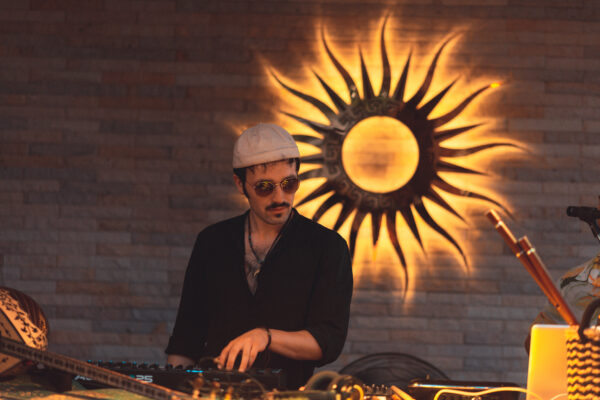As a multi-instrumentalist producer and DJ, Jarl Flamar spreads his imaginative world from stage to stage. Proficient in nearly every Middle Eastern instrument and skilled in sound engineering, he creates hypnotic and powerful oriental house music, suited for both underground clubs and luxurious gardens.
Found at festivals like Fusion, Wonderfruit, Ritual Days, Ozora, and Astropolis, Jarl has performed in a dozen countries. In 2023, his live videos garnered millions of views on YouTube and Instagram.
After a decade honing his unique, organic style with modern sound design, Jarl aims to transport listeners to utopian jungles and faraway deserts under a burning sun.
His latest single Ayahuasca is a skilful balancing of tension and release. It features rich, organic percussion that grounds the rhythm and a strikingly evocative lead synth line that captures the imagination. With its intense build-up and epic breakdown, Ayahuasca track is designed to captivate and energize any dancefloor.
You’re known for blending traditional Middle Eastern instruments with modern electronic sounds. What inspired you to combine these two musical worlds?
I used to travel a lot in North Africa when I was a child and continued exploring several Middle Eastern countries afterward. However, when I started producing electronic music, there wasn’t any Middle Eastern sound in my tracks. I was mostly inspired by Norwegian Space Disco (Lindstrom, Todd Terje…). The oriental aesthetic came bit by bit as I learned to play its most iconic instruments (darbuka, oud, ney, riqq, keyboard…). I realized that playing and incorporating them into my tracks gave me huge emotions, likely related to the memories I had from my journeys in these countries. I’m also quite inspired by psychedelic rock, but that’s another story!
Your performances have been described as transporting listeners to a “revisited Mesopotamia.” Can you elaborate on how you create this immersive experience during your sets?
Mesopotamia is indeed the era that inspires me the most! The way the society was organized, the arts and architecture fascinate me. Not every track I compose is created with that in mind, but many of them are. Middle Eastern acoustic melodies blended with synthesizers make me imagine gods from ancient Mesopotamia. Of course, it’s just a fantasy and not historically accurate, although I try to get as close as possible. I’m using some maqams that are documented to have appeared around the 15th century, and Mesopotamian music was likely quite different from the traditional Middle Eastern music we know nowadays (disclaimer for the musicology experts!).
You’ve performed at numerous festivals across the globe, including Rituel Days and Ozora. Which festival has been the most memorable for you and why?
It’s hard to choose; each of them was a charming adventure! I think the most memorable for me was Wonderfruit festival in Thailand. I played on a beautiful stage next to a pond after nightfall; the design and lights were amazing, and the crowd was enchanting with stunning outfits. I fell in love with this country recently and had the chance to go there three times in one year.
How has your extensive travel influenced your music production and live performances?
As mentioned earlier, my music was considerably inspired by my previous travels, and unsurprisingly, since I started touring internationally, most of my bookings are in countries where the landscapes reflect the aesthetic of it. So it kind of reinforced my inspirations. For example, listening to my own music in Asian nature was a wonderful experience, giving me great creative ideas for future tracks.
Your engineering skills are often highlighted in discussions about your music. How has your technical background shaped your approach to music production?
Actually, I mostly learned everything myself thanks to books and videos, but I’m kind of stubborn until I get exactly what I want, so I spent an insane amount of time crafting the aesthetic I now have. For several years, I barely left my house, trading human relationships for sound design and instrument practice (laugh).
Can you explain the creative process behind your new single “Ayahuasca”? How did you incorporate the concept of the traditional Ayahuasca ceremony into your music?
I was in Ko Samui at Sunrise Studio, a wonderful place at the edge of the jungle. You’re surrounded by birds and geckos making incredible noises. This was the perfect place to create another “jungle-oriented” track, which is my second main inspiration after deserts. We recorded the birds, some wooden stuff, and acoustic instruments with Liam (the studio owner) to create a very organic track illustrating the surrounding atmosphere. In reality, the title doesn’t refer to an actual ayahuasca experience but rather to what it could have been 3000 years ago during the Inca civilization.
With your music signed to influential labels like Baikal Nomads and Art Vibes, how do you choose which labels to work with?
The main reason is how closely the other releases align with my music. I think it’s very important to be in a community to develop ourselves in a healthy way. Also, the relationship with the owners of the label is very important, and I must say that I’ve been quite lucky so far; I’ve connected with very nice people.
Looking ahead, what are your next big projects or goals in your musical journey?
Several other singles are scheduled for release this year, and I hope to have the time to assemble an album for the next one. I’m also looking for the perfect place to move my studio!
Ayahuasca is out now on Flamar Records

